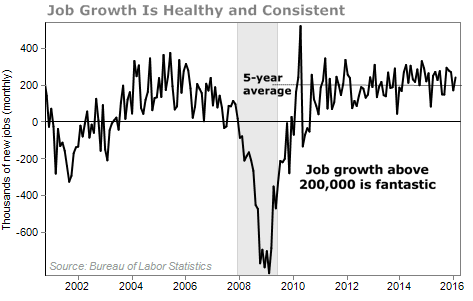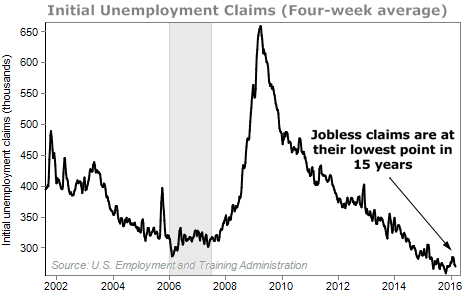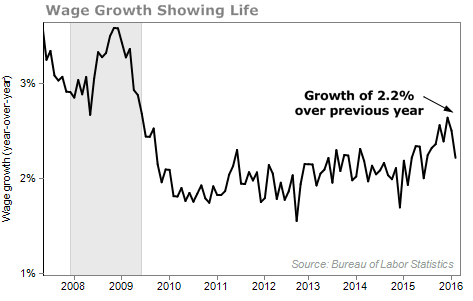The typical American consumer’s wallet is healthier than it has been in a long time…
But you probably don’t believe me.
Virtually everywhere you turn, the mainstream financial media are wringing their hands and agonizing over all the things that could send the markets or the economy into a tailspin.
[ad#Google Adsense 336×280-IA] For example, could a sharp jump in interest rates or a return to high energy prices (however unlikely) cause big problems?
They all are certain that crisis and ruination are around the bend.
Please take a moment and breathe. Yes, the bull market has run for a long time. (A little more than seven years.)
And no, no one can guarantee when the economy might enter a protracted downturn.
Stocks started the year on a sour note and have been volatile ever since. But emotions aside… right now, the strongest signal of economic growth is telling us a different story…
Nothing gives you a better sense of an economy’s health than job growth and employment. You can talk about consumer confidence measures or retail spending or whatever you’d like, but there’s no stronger signal than employers reaching out to hire folks. In terms of the economy, each of those hires represents a new consumer with disposable income.
In March, the Bureau of Labor Statistics (BLS) released a stellar jobs report. Expectations were for jobs to grow by about 190,000 in February. Instead, the economy added 242,000 jobs – a blowout result.
One number only means so much. It’s the trend that matters. But this makes for a record 65 months in a row of positive job growth. There are kids in kindergarten who have never seen a month with a decline in jobs (not that they’ve been paying attention).
For a healthy economy, we want to see job growth in the neighborhood of 200,000 per month. That’s what makes last month’s number look so good. But better than that, we’ve averaged 203,000 going back to October 2010…

And not only are more folks working, but folks are working more… The length of the workweek has been expanding consistently since the end of the financial crisis. At the depths of the recession, the average workweek was 33.7 hours. Now, it’s up to 34.4 hours. That’s good – it means less of the employed are stuck in part-time jobs.
And the number of people who lose their jobs and file unemployment claims each month is at an extremely low level…

Wage growth has been slow, but it’s starting to show up now. This February, workers earned 2.2% more than they did last February…

More jobs and rising wages mean more things to buy. Don’t forget, as well, that the plummet in energy prices has put billions into the pockets of consumers. Estimates put the savings at about $700 per household, per year.
So if you’re worried today, don’t be. The typical American consumer has a healthier wallet than he has had in a long time.
Here’s to our health, wealth, and a great retirement,
Dr. David Eifrig
[ad#stansberry-ps]
Source: Daily Wealth
